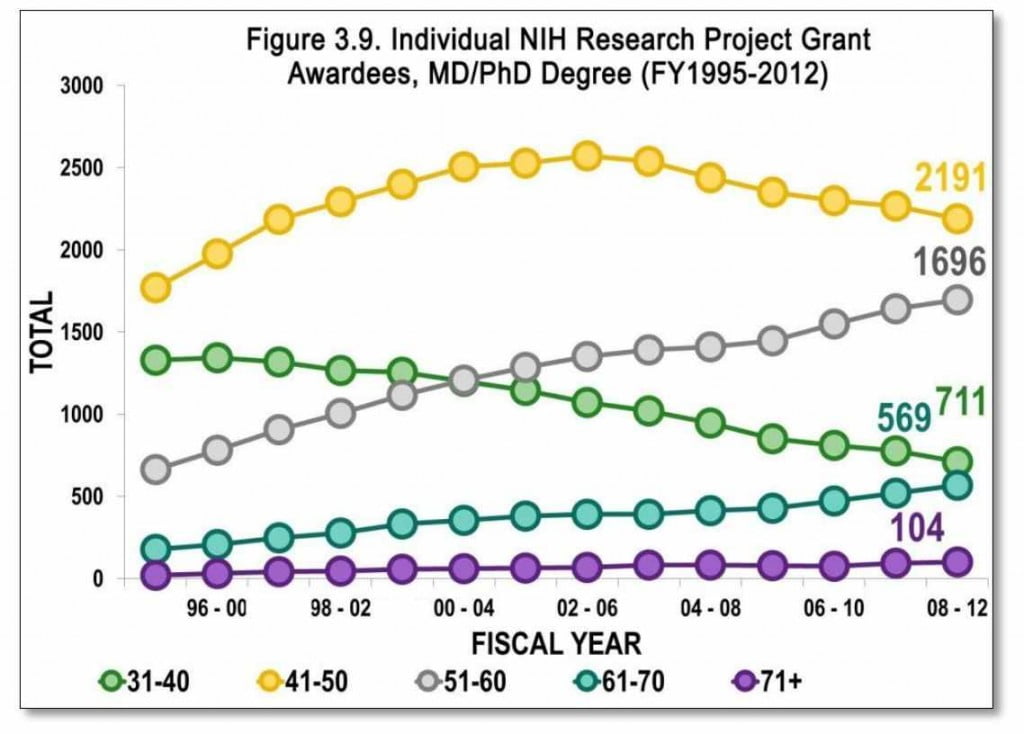The Change of Life
No, not that change of life!
Dr. J. spent a good amount of his training time in research related activities, and actually held a grant or two from the NIH at various times in his career.
At a critical juncture in Dr. J.’s career, it became apparent to Dr. J. that given the lack of positive data, and the unforgiving nature of the tenure clock that transitioning to a clinical track was the way to go. In the Ivory Tower there are plenty of opportunities to be scholarly as a collaborator or a principal investigator on a clinical trial and to teach without Damocles’ sword sitting above your head.
Dr. J. saw the writing on the wall years ago with tenured faculty members being productive into their late 60s, 70s and even 80s, albeit with help from young non-tenured faculty members who, rather than go on to be independent investigators themselves, chose to partner with a senior faculty member. The NIH budget wasn’t growing very fast, and higher and higher scores were needed on grants to achieve funding. Consequently, working in Dr. Famous Professor’s well oiled machine is a safer environment than striking out for one’s self, partly because all of the Dr. Famous Professor’s across the country are still getting their share of finite dollars, leaving less finite dollars for younger faculty.
Back in the day, the goal was to get out from under Dr. Famous Professor, now, that isn’t as frequent an occurrence.
Dr. J. had no proof to go along with his observations about the changing landscape of 21st century NIH funded science until now.
If the total number of physician-scientists (PS’s) is growing, but number of new ones remains static, in other words, the old ones aren’t leaving the workforce.
In less than a decade the number of PS’s in their 50s-70s have almost doubled, while the number of younger docs have shrunk.
Why is that?
 The number of grant dollars going to scientists in their 50s and 60s is going up while the dollars going to those in their 30s and 40s are going down. There even appears to be a little uptick in septuagenarian grant funding.
The number of grant dollars going to scientists in their 50s and 60s is going up while the dollars going to those in their 30s and 40s are going down. There even appears to be a little uptick in septuagenarian grant funding.
Why is that? Well, the numbers reflect the aging population (these are not indexed numbers which would have been helpful)? Similarly, as grant holders cross the threshold of one decade to the next, any grants they hold go along with them.
There is both good and bad in this. The good news is that dollars are going to seasoned investigators who are well oiled research machines. The bad news is that it is a short term win and a long term loss.
There will be a small number of Gen-X and Millennial physician scientists who pass through the eye of the needle, but they will be well equipped to be successful on the other side, when the Silent Generation and Baby Boomer Scientists ultimately leave the field. What also will happen is a shortage of scientists to replace those leaving, and a lot of future funding will go to waste on potentially ill equipped physician-scientists, or be monopolized by those who made it.
The other problem with funding these well oiled research machines so well is that there is a certain ‘old boys network’ with regard to peer review, and those that challenge the orthodoxy may struggle to get funded while scientists who make incremental advances in what were previously wide open fields are still getting money hand over fist. There will be incremental, and potentially esoteric progress at the expense of fewer breakthroughs.
The individual mentoring that once happened doesn’t seem to be happening anymore. Dr. J. blames successful, robust older mentors who aren’t quite done yet, and he blames their mentees who aren’t striving as aggressively to be independent.
While institutions have a vested interested in creating the next generation of physician scientists (and all of the grant dollars they will bring in), and are very supportive of them, funding their independence is becoming harder and harder because the dollars aren’t there and the young investigators, in aggregate, aren’t trying as hard to become independent, as they are to support their mentor.


